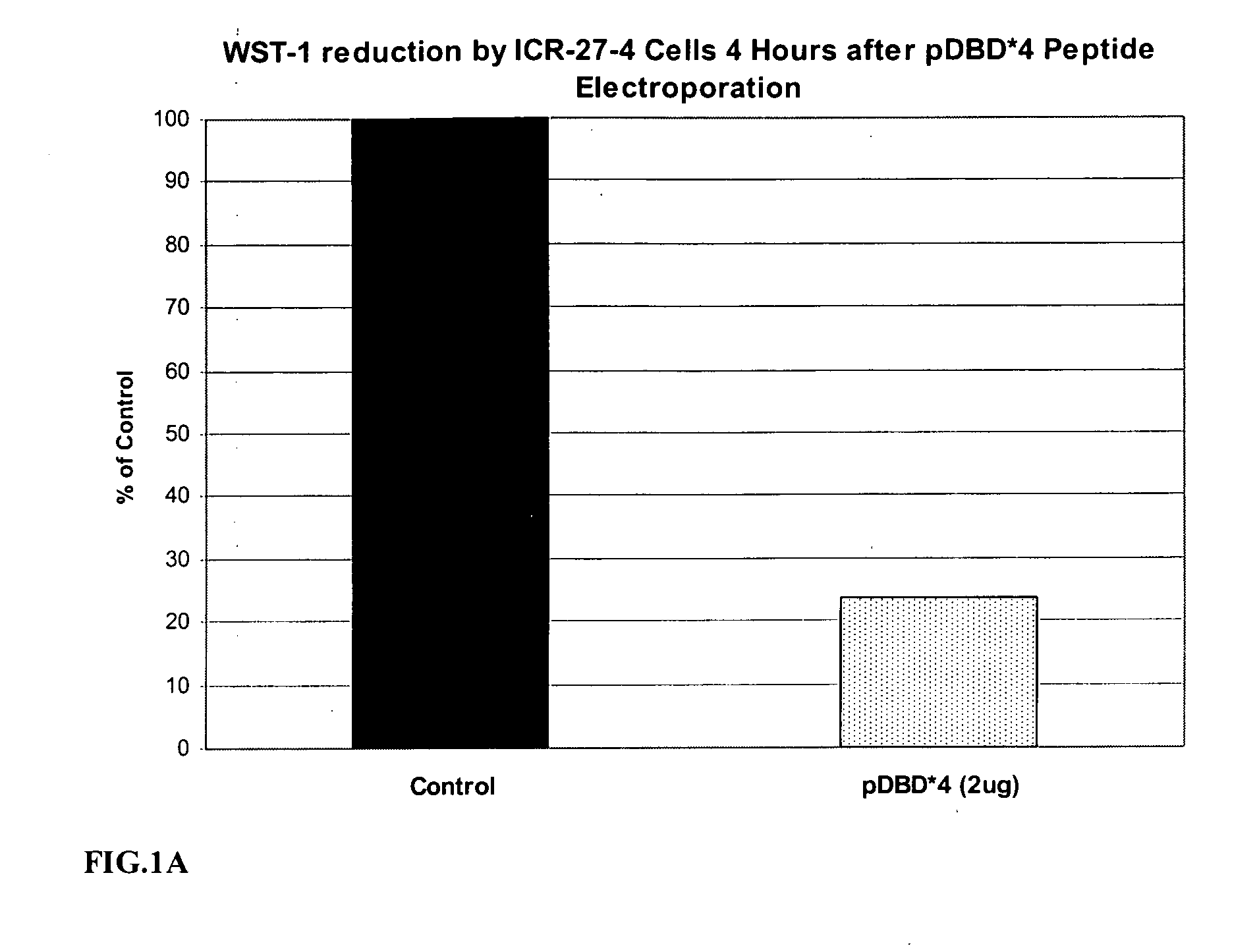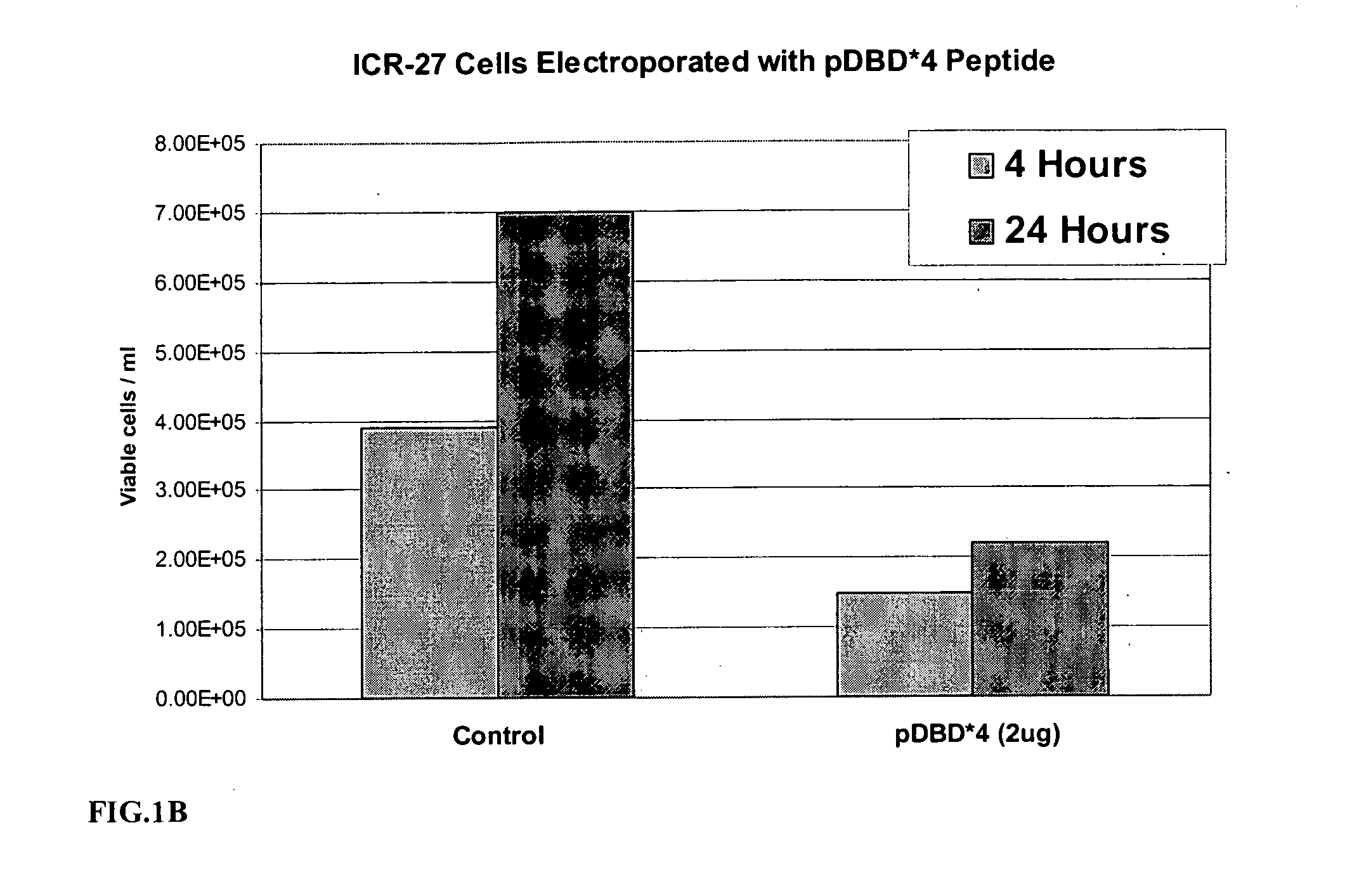Anticancer peptide
a technology of anticancer peptides and peptides, which is applied in the field of toxic polypeptides, can solve the problems of cancers that respond poorly to chemotherapy, uncontrolled growth of malignant cells, and death of patients
- Summary
- Abstract
- Description
- Claims
- Application Information
AI Technical Summary
Benefits of technology
Problems solved by technology
Method used
Image
Examples
example 1
[0035]
TABLE 1Reduction in ICR 27 leukemic cells by application of pDBD * 4R9A. Cells / ml after 23 hVehicle OnlyGnRHR7pDBD * 4R96.4 × 15 5 μM5.1 × 1051.8 × 10510 μM5.2 × 1051.95 × 105 20 μM5.3 × 1050.5 × 105
[0036] At t=0, growing cells were removed from medium, washed, and plated at 4.0×106 cells / ml in serum-free medium to which the peptide was added from a stock solution. Control peptide was GnRHR7 (Gonadotropin Releasing Hormone with a 7-arginine polymer added covalently). One hour later cells were diluted into growth medium. After 23 h, each culture was counted in duplicate. Average values are shown. Similar dose-related responses to pDBD*4R9 have been seen in 3 experiments.
[0037] Comparison of the ability of pDBD*4 and pDBD*4R9 to kill ICR-27 leukemic cells showed that without electroporation, pDBD*4R9 added exogenously killed the cells in a dose dependent manner, whereas pDBD*4 did not.
[0038] The use of a PTD in the embodiment pDBD*4R9 allowed tests of the effect of the inventi...
example 2
[0046] This example shows the effect of pDBD*4R9 on the human leukemic cell line, CEM; human breast cancer line MCF-7; and colon cancer line, CaCo-2.
[0047] For each cell line, the protocol was the same for determining the effects of pDBD*4R9.
[0048] Cells were plated in equal numbers and washed free of growth medium.
[0049] The peptide pDBD*4R9 was then added to the cells for one hour, after which they were returned to growth medium.
[0050] At a suitable interval thereafter, they were assayed for viability by use of the WST assay (described above), which measures the ability of viable cells' mitochondria to metabolize and therefore change the color of a water soluble tetrazolium dye (WST). By measuring the absorbance of the color, one has a quantitative correlate of viability: More absorbance=more viable cells.
[0051] In the experiment on MCF-7 cells, an equivalent assay (AlarmarBlue) was used.
[0052] The data for the colon cancer cell line CaCO was as follows.
Absorbance(viabilit...
PUM
| Property | Measurement | Unit |
|---|---|---|
| size | aaaaa | aaaaa |
| concentrations | aaaaa | aaaaa |
| eds | aaaaa | aaaaa |
Abstract
Description
Claims
Application Information
 Login to View More
Login to View More - R&D
- Intellectual Property
- Life Sciences
- Materials
- Tech Scout
- Unparalleled Data Quality
- Higher Quality Content
- 60% Fewer Hallucinations
Browse by: Latest US Patents, China's latest patents, Technical Efficacy Thesaurus, Application Domain, Technology Topic, Popular Technical Reports.
© 2025 PatSnap. All rights reserved.Legal|Privacy policy|Modern Slavery Act Transparency Statement|Sitemap|About US| Contact US: help@patsnap.com



